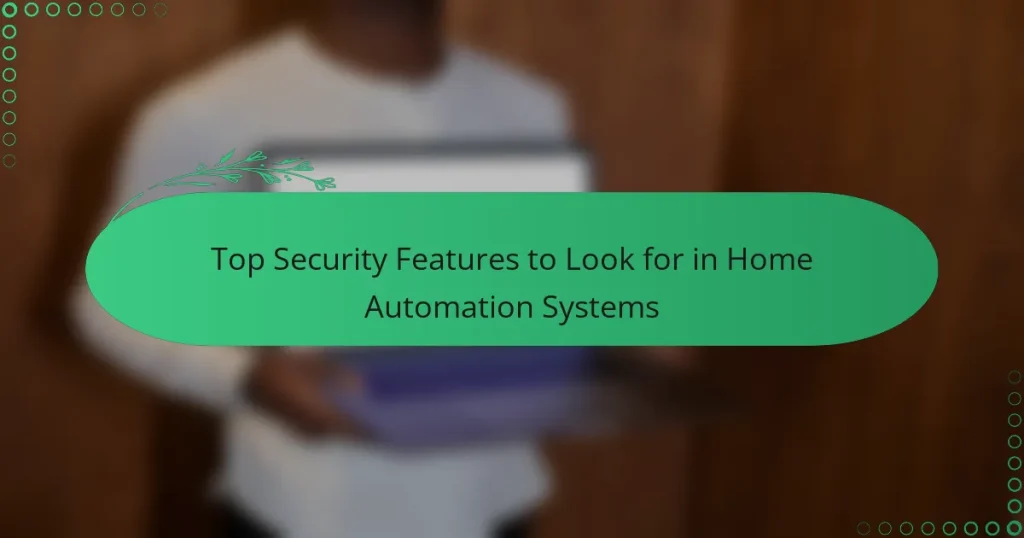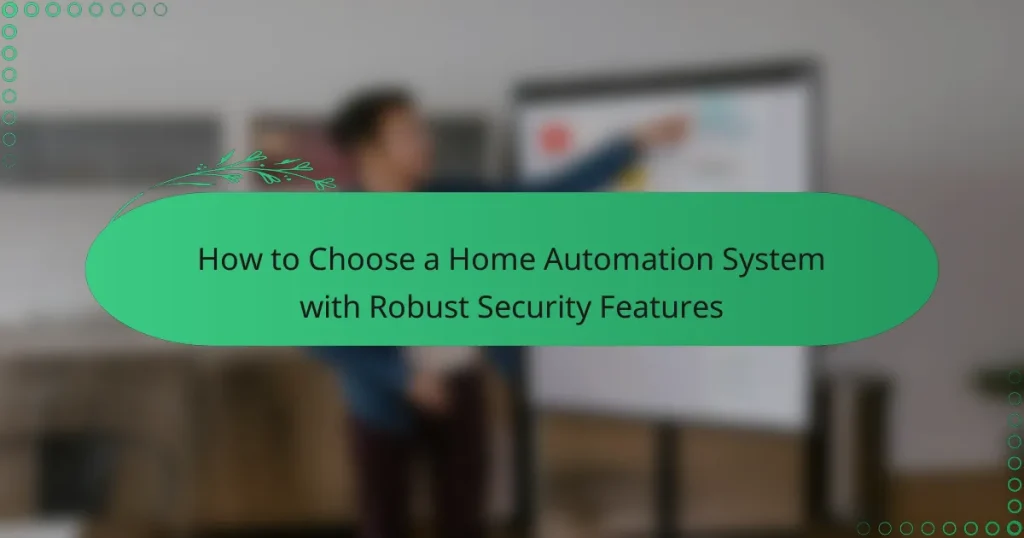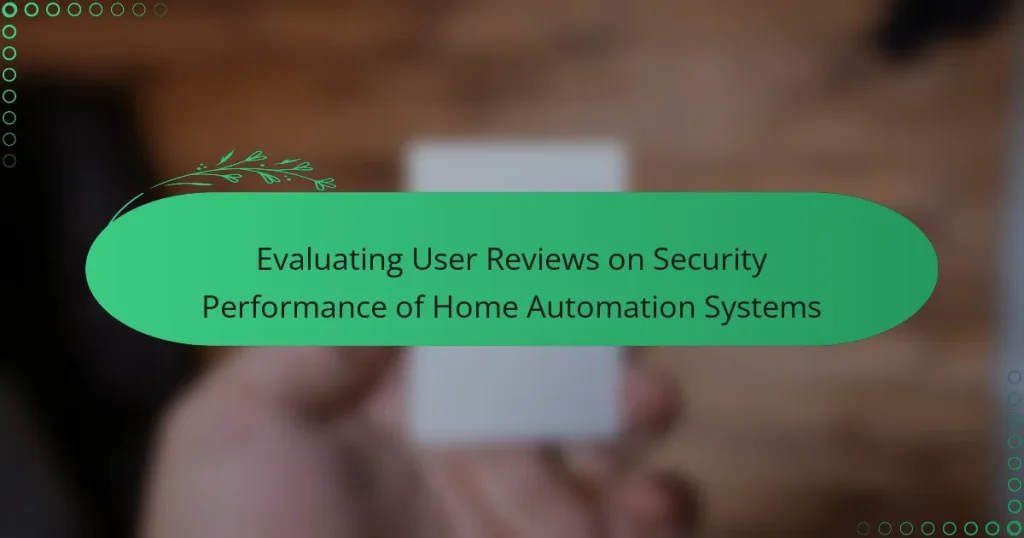Home automation systems significantly enhance residential security through a variety of advanced features. With smart locks, surveillance cameras, motion sensors, and alarm systems, homeowners can monitor and control access to their properties remotely. These technologies not only deter potential intruders but also provide peace of mind by ensuring comprehensive protection around the clock.
How to Choose a Home Automation System with Robust Security Features
Evaluating User Reviews on Security Performance of Home Automation Systems
What are the key security features of home automation systems?
Home automation systems offer several key security features that enhance the safety of residential properties. These features include smart locks, surveillance cameras, motion sensors, alarm systems, and remote monitoring, all designed to provide comprehensive protection and peace of mind.
Smart locks
Smart locks allow homeowners to control access to their properties remotely, often via a smartphone app. They can be programmed to grant temporary access to guests or service providers, eliminating the need for physical keys.
Many smart locks use encryption and two-factor authentication to enhance security. When choosing a smart lock, consider features like auto-locking, integration with other smart home devices, and battery life.
Surveillance cameras
Surveillance cameras are essential for monitoring the exterior and interior of a home. They can provide real-time video feeds and alerts when motion is detected, helping to deter potential intruders.
Look for cameras with high-definition video quality, night vision, and cloud storage options. Some models also offer features like facial recognition and two-way audio, allowing for interactive monitoring.
Motion sensors
Motion sensors detect movement within a designated area and can trigger alarms or notifications. They are commonly used in conjunction with other security devices to enhance overall protection.
When selecting motion sensors, consider their range, sensitivity, and whether they can differentiate between pets and humans. Wireless options are often easier to install and integrate into existing systems.
Alarm systems
Alarm systems serve as a primary line of defense against unauthorized entry. They can be set to trigger loud alarms and notify homeowners or authorities when a breach is detected.
Modern alarm systems often include features like smartphone alerts, integration with smart home devices, and customizable settings. It’s important to choose a system that fits your specific security needs and budget.
Remote monitoring
Remote monitoring allows homeowners to keep an eye on their property from anywhere using a smartphone or computer. This feature is crucial for those who travel frequently or want to ensure their home is secure while they are away.
Many home automation systems offer apps that provide live feeds from cameras, alerts from sensors, and control over locks and alarms. Ensure that the system you choose has a user-friendly interface and reliable connectivity options.
How do smart locks enhance home security?
Smart locks significantly improve home security by providing advanced access control features that traditional locks cannot offer. They enable homeowners to manage entry points remotely, track access history, and eliminate the need for physical keys.
Keyless entry
Keyless entry systems allow users to unlock doors without traditional keys, using methods such as keypads, smartphone apps, or biometric scans. This feature enhances convenience and security, as it reduces the risk of lost or stolen keys. Many smart locks offer customizable access codes, allowing homeowners to grant temporary access to guests or service providers.
Remote access control
With remote access control, homeowners can lock or unlock their doors from anywhere using a smartphone or tablet. This feature is particularly useful for monitoring entry points while away from home, providing peace of mind. Some systems even allow for real-time notifications when someone enters or exits, enabling users to stay informed about who is accessing their property.
Activity logs
Activity logs provide a detailed record of who accessed the home and when, enhancing security by allowing homeowners to monitor entry patterns. This feature can help identify unauthorized access attempts or confirm that family members have returned home safely. Many smart locks store logs for several months, making it easy to review past activity and maintain a secure environment.
What role do surveillance cameras play in home automation?
Surveillance cameras are essential components of home automation systems, enhancing security by providing real-time monitoring and recording capabilities. They help homeowners keep an eye on their property remotely, deterring potential intruders and ensuring peace of mind.
Live video feeds
Live video feeds allow homeowners to view real-time footage from their surveillance cameras via smartphones, tablets, or computers. This feature is crucial for monitoring activities around the home, whether you are at work or on vacation. Many systems offer high-definition video quality, enabling clear visuals even in low-light conditions.
When selecting a camera, consider options that support remote access and have a user-friendly app interface. Look for features like pan-and-tilt capabilities to cover larger areas and multiple camera support for comprehensive surveillance.
Motion detection alerts
Motion detection alerts notify homeowners when movement is detected within the camera’s field of view. This feature is vital for identifying potential security threats in real-time, allowing for immediate action if necessary. Alerts can be sent via push notifications or emails, ensuring you stay informed no matter where you are.
To maximize effectiveness, adjust the sensitivity settings to minimize false alarms caused by pets or passing vehicles. Some systems allow customization of detection zones, so you can focus on critical areas like entry points or driveways.
Cloud storage options
Cloud storage options provide a secure way to store recorded footage from surveillance cameras, ensuring that video data is accessible even if the camera is damaged or stolen. Many home automation systems offer subscription plans for cloud storage, which can vary in terms of storage capacity and retention periods.
When choosing a cloud storage plan, consider factors such as the duration of video retention, the number of cameras supported, and the associated costs. Some systems offer free storage for a limited time, while others may charge a monthly fee for extended access. Always ensure that the provider uses strong encryption to protect your data.
How can motion sensors improve home safety?
Motion sensors enhance home safety by detecting movement and triggering alerts or responses. They provide real-time monitoring, allowing homeowners to respond quickly to potential threats.
Intruder alerts
Motion sensors can send instant alerts to homeowners via smartphone notifications or alarms when they detect unauthorized movement. This immediate feedback allows for quick action, whether that means contacting authorities or checking security cameras.
Many systems allow customization of alert settings, enabling users to adjust sensitivity levels to reduce false alarms caused by pets or environmental factors. It’s crucial to regularly test and maintain these sensors to ensure they function correctly.
Integration with lighting systems
Integrating motion sensors with lighting systems can enhance security by automatically illuminating areas when movement is detected. This not only deters intruders but also provides visibility for residents returning home at night.
Homeowners can set up smart lighting to activate in specific zones, such as entryways or backyards, creating a well-lit environment that discourages unauthorized access. Consider using LED lights for energy efficiency and longevity.
Energy efficiency
Motion sensors contribute to energy efficiency by ensuring lights and appliances are only active when needed. This can lead to noticeable reductions in electricity bills, especially in larger homes.
For example, sensors can turn off lights in unoccupied rooms or adjust heating and cooling systems based on occupancy. Homeowners should evaluate their usage patterns to maximize the benefits of these energy-saving features.
What are the benefits of alarm systems in home automation?
Alarm systems in home automation provide enhanced security by offering real-time monitoring and immediate responses to potential threats. These systems can deter intruders, alert homeowners, and integrate with other smart devices for comprehensive protection.
Immediate alerts
Immediate alerts are a crucial feature of alarm systems, notifying homeowners of any suspicious activity as it occurs. When a sensor is triggered, the system sends instant notifications via smartphone apps, text messages, or emails, allowing for quick action.
For example, if a door or window sensor detects unauthorized entry, the homeowner receives an alert within seconds. This rapid response can be vital in preventing theft or damage.
Integration with emergency services
Many home automation alarm systems can be integrated with local emergency services, providing an added layer of security. When an alarm is triggered, the system can automatically contact police, fire, or medical services, ensuring a swift response.
This integration can significantly reduce response times, as emergency services are alerted without delay. Homeowners should check if their system complies with local regulations for emergency notifications to ensure proper functionality.
Customizable settings
Customizable settings allow homeowners to tailor their alarm systems to meet specific security needs. Users can adjust sensitivity levels, set schedules for when the system is active, and choose which sensors to include in their alerts.
For instance, a family might want to set the alarm to activate only during nighttime hours or when no one is home. This flexibility helps maintain security while accommodating daily routines.


